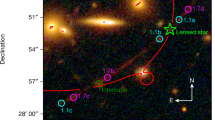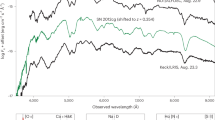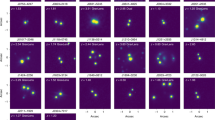Abstract
The surface mass density (Σ) of clusters of galaxies and super-clusters is normally too low to split images1–5, even for a large source redshift (zs) and an optimal lens redshift (zi). Because the distribution function of Σ decreases steeply with Σ, a cluster or supercluster found responsible for multiple imaging has a high probability of being a marginal lens5. Such a lens, barely able to split images of a distant source, has a subcritical surface mass density and remarkable properties unlike those of lenses with a density above critical. As I show here, these properties can easily be recognized observationally when the image separation is larger than is normal for a lens made of a galaxy: (1) there may be no prominent excess of galaxies and no microwave background inhomogeneities in the immediate area of the images, (2) there may be an enhancement of the number of observable quasars at very different redshifts in an area much larger than the image separation, (3) there may be split images in the vicinity of unsplit images of other sources of even larger redshifts. If split images of the same source separated by many arc seconds are observed and the responsible lens is a non-exotic object, for example, a cluster, a group of clusters or a collapsing protocluster seen edgewise, it is likely to be marginal. Modern techniques permit a specific search for these lenses, which could constrain theories of structure fermation in the Universe.
This is a preview of subscription content, access via your institution
Access options
Subscribe to this journal
Receive 51 print issues and online access
$199.00 per year
only $3.90 per issue
Buy this article
- Purchase on Springer Link
- Instant access to full article PDF
Prices may be subject to local taxes which are calculated during checkout
Similar content being viewed by others
References
Sanders, R. H., van Albada, T. S. & Oosterloo, T. O. Astrophys. J. 278, L91–L94 (1984).
Narayan, R., Blandford, R. & Nitiyananda, R. Nature 310, 112–115 (1984).
Turner, E. L., Ostriker, J. R. & Gott, J. R. Astrophys. J. 284, 1–22 (1984).
Subramanian, K. & Cowling, S. A. Mon. Not. R. astr. Soc. 219, 333–346 (1986).
Kovner, I. Astrophys. J. (in the press).
Sarazin, C. L. Rev. mod. Phys. 58, 1–115 (1986).
Ostriker, J. P. & Vishniac, E. T. Nature 322, 804 (1986).
Oort, J. H. A. Rev. Astr. Astrophys. 21, 373–428 (1983).
Efstathiou, G. & Silk, J. Fundam. Cosmic Phys. 9, 1–138 (1983).
Jaroszyński, M. & Paczyński, B. in Proc. Second Eur. Reg. Mg (IAU) (Memorie Soc. astr. ital. 45) 673–480 (1974).
Schneider, P. Astr. Astrophys. 143, 413–420 (1984).
Blandford, R. & Narayan, R. Astrophys. J. 310, 568–582 (1986).
Kovner, I. Astrophys. J. (in the press).
Kovner, I. Astrophys. J. (in the press).
Struble, M. F. & Rood, H. J. Astr. J. 87, 7–46 (1982).
de Lapparent, V., Geller, M. J. & Huchra, J. P. Astrophys. J. 302, L1–L5 (1986).
Tago, E., Einasto, J. & Saar, E. Mon. Not. R. astr. Soc. 218, 177–184 (1986).
Arnold, V. I., Shandarin, S. F. & Zel'dovich, Ya. B. Geophys. Astrophys. Fluid Dyn. 20, 111–130 (1982).
Vishniac, E. T., Ostriker, J. P. & Bertschinger, E. Astrophys. J. 291, 399–416 (1985).
Bourassa, R. R., Kantowski, R. & Norton, T. D. Astrophys. J. 185, 747–756 (1973).
Kaiser, N. & Stebbins, A. Nature 310, 391–393 (1984).
Stark, A. A., Dragovan, M., Wilson, R. W. & Gott, J. R. Nature 322, 805 (1986).
Sanders, R. H. Nature 309, 35–37 (1984).
Kapahi, V. K., Subramanyan, R. & Singal, A. K. Nature 313, 463–465 (1984).
Windhorst, R. thesis, Univ. Leiden (1984).
Turner, E. L. et al. Nature 321, 142–144 (1986).
Shaver, P. A. & Cristiani, S. Nature 321, 585–586 (1986).
Phinney, E. S. & Blandford, R. D. Nature 321, 570–571 (1986).
Arp, H. & Hazard, C. Astrophys. J. 240, 726–736 (1980).
Paczyński, B. Nature 321, 419–420 (1986).
Gott, J. R. Nature 321, 420–421 (1986).
Paczyński, B. Nature 319, 567–568 (1986).
Tyson, J. A., Valdes, F., Jarvis, J. F. & Mills, A. P. Astrophys. J. 281, L59–L62 (1984).
Dyer, C. C. & Roeder, R. C. Astrophys. J. 174, L115–L117 (1972).
Huchra, J. P. Nature 323, 784–786 (1986).
Author information
Authors and Affiliations
Rights and permissions
About this article
Cite this article
Kovner, I. Marginal gravitational lenses of large separation: probing superclusters. Nature 325, 507–509 (1987). https://doi.org/10.1038/325507a0
Received:
Accepted:
Issue Date:
DOI: https://doi.org/10.1038/325507a0
Comments
By submitting a comment you agree to abide by our Terms and Community Guidelines. If you find something abusive or that does not comply with our terms or guidelines please flag it as inappropriate.



